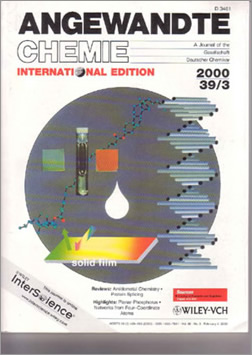Advanced Functional Materials, Vol. 17, 2007
An illustration of the phototriggered organization and dispersion of tri-peptide-substituted azobenzene derivatives, as reported on p. 1507 by Yoko Matsuzawa and co-workers. The tri-peptide units form a beta-sheet structure through hydrogen bonding to assemble a fibrous network system. Cis-trans photoisomerization of the azobenzene moiety leads to a large polarity change of the component molecule to break and re-form hydrogen bonds between the tri-peptide units.
Chemical Society Reviews, Vol. 33, 2004
The cover shows a colour image that is able to be reversibly recorded on a liquid crystalline film composed of the dimesogenic cholesteryl ester and azobenzene derivative. The different colours are produced by varying the amount of UV exposure at high temperature. When the film is cooled to room temperature the film becomes solid and the colours are stable. See the article.
The Journal of Organic Chemistry, Vol. 68, 2003
The crystal structures of azobenzenophanes, in which two (dimer), three (trimer), and four (tetramer) azobenzene units are connected cyclically bymethylene linkers. All three isomers of the dimer are shown, and the trimer and tetramer formed supramolecular channel structures where solvent molecules are inside of the cavity. See Tamaoki and co-workers, p 8291.
Langmuir, Vol. 16, 2000
Fibrous Structures of Photopolymerizable Organogels from a Cholesterol-Diacetylene Gelator
Angewandte Chemie International Edition, Vol. 39, 2000
The cover picture shows at the top left green and red solid films that are formed by spin coating the transparent solution (shown between the samples) of a nonpolymeric dicholesterylester (ball-and-stick-model shown in the background). The iridescent colors of the solid film can be controlled by changing the temperature within a region in which the diester is crystalline. Transmission, circular dichroism, and optical rotation dispersion spectra reveal that the helical ordering of the molecules (shown at the right) is the origin of this phenomenon for nonpolymeric compounds and may provide a simple method for preparing reflecting films. Further details on the synthesis and properties of these colorful supramolecular aggregates are reported by N. Tamaoki et al. on p. 509 ff.


Advanced Materials, Vol.12, 2000
The cover shows full-color images that are able to be reversibly recorded on a liquid-crystalline film composed of the cholesteryl ester and azobenzene depicted. The different colors are produced by varying the amount of UV exposure at high temperature. When the film is cooled to room temperature the film become solid and the colors are stable. Full details are to be found in the article by Tamaoki et al. on page 94.
Advanced Materials, Vol.9, 1997
The cover shows photographs, taken at room temperature, of colored images produced in a thin solid cholesteric film, together with the chemical structure of the cholesteryl derivative used. The various colors are produced by slightly different thermal treatments. Full details of this first step towards the realizations of rewritable full-color recording are to be found in the article by Tamaoki et al. on page 1102.
|